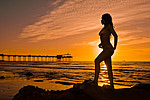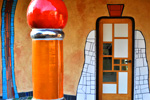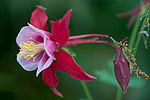Best Superzoom Cameras under $500
THIRD PLACE
Sony Cyber-shot DSC-HX100V
Sony Cyber-shot DSC-HX100V
The Sony DSC-HX100V is another hot and competitive superzoom camera. It is loaded with features that do not exist on the other cameras, from a 3D panorama mode to the ability to pre-determine the size of a subject's smile before triggering the shutter (seems a bit overboard, I know, but it is there). And at 16 MP, it gets consumer's attention because it is the highest resolution model in the bunch (the others are all 12 MP). We had a lot of fun playing with this one due to its amazingly fast focus and shutter release. It's fast action feels almost like a much more sophisticated and expensive DSLR camera.
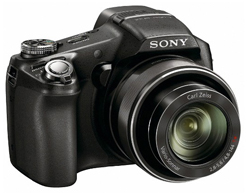 |
What's HOT about the Sony HX100V:
1. 30X zoom range with 810mm telephoto end--almost the reach of the Canon SX40
2. 16MP resolution, reasonably solid image sharpness
3. Fast action, rapid focus and shutter release
4. Outstanding electronic viewfinder, bright, rapid response, easy to see, even exceeds the FZ150
5. Auto panorama mode with 3D option (no other superzoom camera has this)
6. Still photos in 3D
7. 1080p 60 video, very nice job with HD movies
8. GPS (no other superzoom in this shootout has GPS)
9. HDR mode--very sharp pictures, but contrast is harsh
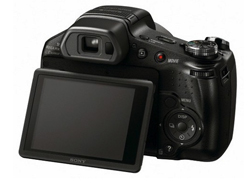 |
What's NOT so hot about the Sony HX100V:
1. Color tends to bias toward blue in auto default modes.
2. Underexposes photos in default settings--you need to use +EV settings to correct it.
3. Wide angle is not quite as wide--27mm compared to the FZ150's 25mm, the SX40's 24mm, and the P500's ultrawide 22.5mm
4. Limited vertical LCD screen movement
5. LCD screen very difficult to see in sunlight
6. Screen gets easily smudged in use, which makes it even harder to see
7. No hot shoe for external flash or mic
8. Burst mode--10 frames per second, 10 frames max. Not bad. The Panny FZ150 shoots 12 fps and buffers 12, but the Canon SX40 shoots at 10.3 fps and buffers only eight.
9. No RAW capture (only the Panny FZ150 has it).
10. Goofy lens cap design--pops off automatically when camera is powered on; you need to leave the lens cap attached to the camera with a string, so it dangles from the lens while you are shooting. Otherwise you will lose it.
11. HDR images are sharp but harsh, lacking shadow detail.
A Look at the Sony Cyber-shot HX100V
First, the Sony HX100V is fun, fun, fun. Designed for the casual user, families on vacations, and most people who love taking snapshots but don't think of their photography as fine art. Though it has a boatload of features and controls, its basic operation is designed to be easy. In theory you should be able to set it into Intelligent Auto mode and go about your day. And you can, if you are not too picky about exposure and color balance.
The HX100V can take a wide array of photographs from any given vantage point due to its long 30x zoom range:
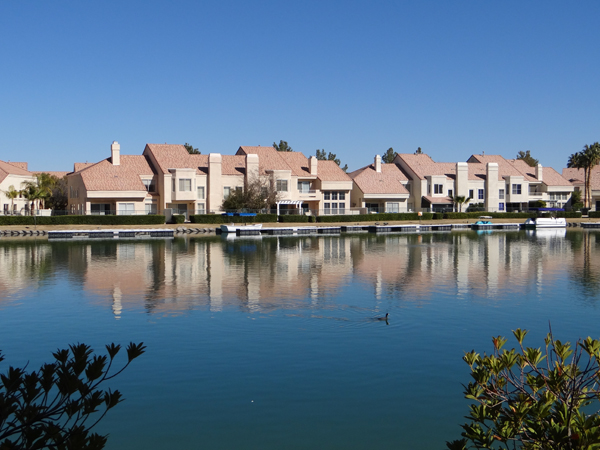 Sony HX100V, Maximum Wide Angle
Sony HX100V, Maximum Wide Angle(not quite as wide as the competition, but not bad)
See that boat near the right edge of the picture above? The HX100V will zoom in to isolate just that boat, if that is what you want:
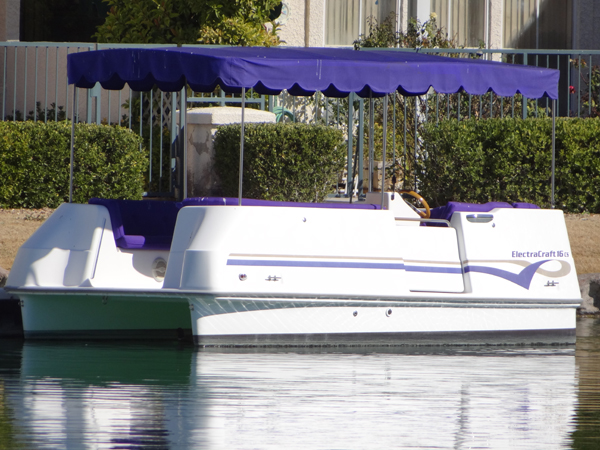
from same location as previous photo
Excellent viewfinder.The electronic viewfinder is terrific--big, bright, and fast, easily illuminating the scene, the closest thing to an optical viewfinder in this shootout. That makes the camera ideal as a scope for hunting out and composing those photos.
LCD screen, good but...The LCD screen on the back is a large 3" diagonal with high resolution. It flips out as illustrated above, but there is a problem with this design. Do you use sunscreen or lotion, or is your skin naturally oily? When you hold the camera up to your eye to use that great viewfinder, your nose and cheek will touch the screen. Before you know it, the screen is covered with smudges. It is hard to see the screen in sunlight even when it is clean, but it is even harder to see when covered with CopperTone. Both the HX100V and the Nikon P500 have screens like this, and they suffer from this problem equally.
Fast response.THe HX100V focuses on a scene faster than any camera in this shootout, and it takes the picture immediately with the press of the button--virtually no shutter lag. Once the picture is taken, it displays a preview for a second longer than some might like, and this slows you down a bit. But as you are shooting, you get the feeling that the camera is capturing exactly the pictures you want, which is a good feeling to have.
But the problem is....Picture Quality. Three picture quality issues must be discussed. First, color is not as accurate on the HX100V as it is on the Panasonic FZ150 or even the Canon SX40. In bright sun it tends to capture images with a cooler color temperature. Sometimes that is no problem. If you are shooting snowcapped Mt. Fuji against a deep blue sky, the cooler color temp will make the snow brilliant white and the sky a dramatic blue. But it will also reduce the warmth of skin tones, which is not a good thing. Yellows and reds tend to be muted.
On the HX100V color temperature can be corrected to some degree with the white balance controls in the menu, and it can be corrected more comprehensively in a photo editor after the fact. But who wants to?


Sony HX100V Panasonic FZ150
(both cameras at maximum zoom, from a distance of 42 feet)
The HX100V also tends to smear reds when they are adjacent to contrasting colors. You can see this in Photoscope:
In this Photoscope comparison of the HX100V with the Panasonic FZ150, go to the red/white checkered cloth. You can see that on the HX100V, the red stripes bleed into the white, rendering the white stripes pink. On the FZ150, the white remains pure and unpolluted. The same phenomenon is visible on the Colman's Mustard label, with the surrounding yellow being compromised with red tint.
As you can see above, the Sony HX100V has a longer telephoto reach than the Panasonic FZ150. But the FZ150 captures the actual color of the wall, while the HX100V biases heavily toward blue. This can be minimized through trial and error by adjusting the white balance controls. But most users looking for a simple snapshot camera that works out of the box may not wish to mess with it.
The cinder block wall is somewhat of a test pattern subject. Here is how the color inaccuracy manifests itself in an actual street scene:
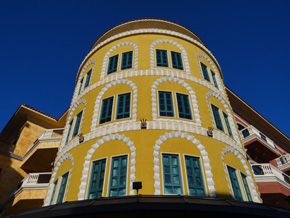

The Sony HX100V, on the left, tends to underexpose and
bias toward blue, compared to the Canon SX40 on the right.
The second picture quality issue is that the HX100V (in automatic modes) underexposes most pictures (as you can see above). This can be corrected by bumping the EV control to +0.3 or +0.7, but the degree of underexposure is not obvious on the LCD screen. The serious photo enthusiast will have no trouble learning the camera and making the requisite adjustments, but the casual user won't be paying attention. This is supposed to be a fully automatic, easy to use camera, so it would have been terrific if it would render better exposures without fussing with it. The Panasonic FZ150 and Canon SX40 usually capture more accurate pictures in their automatic modes, both in terms of color balance and exposure.
The third picture quality problem on the HX100V is sharpness, or lack thereof. You'd think a 16 megapixel camera would have the best sharpness and more detail compared to the 12 MP competition. Think again. Here is a small segment of our test scene taken with both the HX100V and the Panasonic FZ150 with lenses at maximum zoom. These images illustrate that having a lot of megapixels does not translate to image quality or sharpness:

Sony HX100V, 16 MP,
cropped section of photo at long zoom
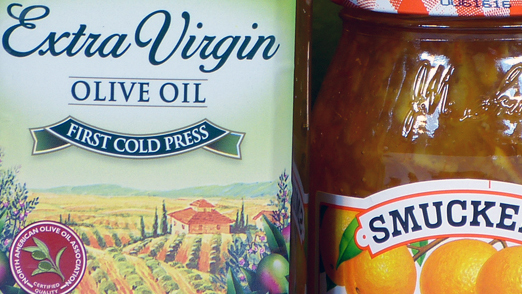
Panasonic FZ150, 12 MP,
cropped section of photo at long zoom
Conclusion. The Sony HX100V is lots of fun to shoot, with its rapid focus and fast shutter release. And it's got on-board GPS, and 3D panorama mode that the others don't have. It's got an amazing (some might say even wacky) smile detection system that let's you define the size of the smile required before it will take the picture. Seriously. And if there are both adults and children in a scene, you can actually tell the camera ahead of time whether you want it to keep either the adults or the children in focus if it needs to decide between the two. No other camera in this group has this array of over the top consumer oriented features.
We were having a great time playing with the HX100V in the field. It was not until we got back home and started looking at the results that our enthusiasm for this camera began to wane. Sony engineers might have been better off trying to optimize basic photo quality rather than inventing a boatload of gimmicks. As fun as it is, the HX100V's problems with color accuracy, exposure, and image sharpness were enough to drop it into third place in this shootout.


